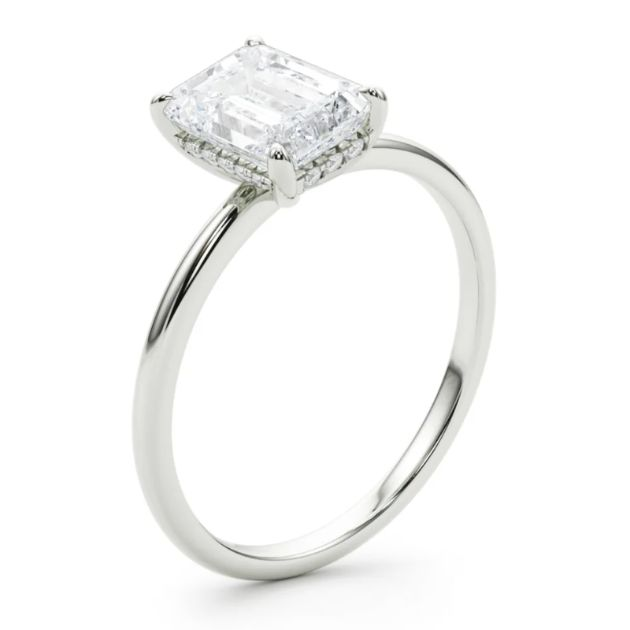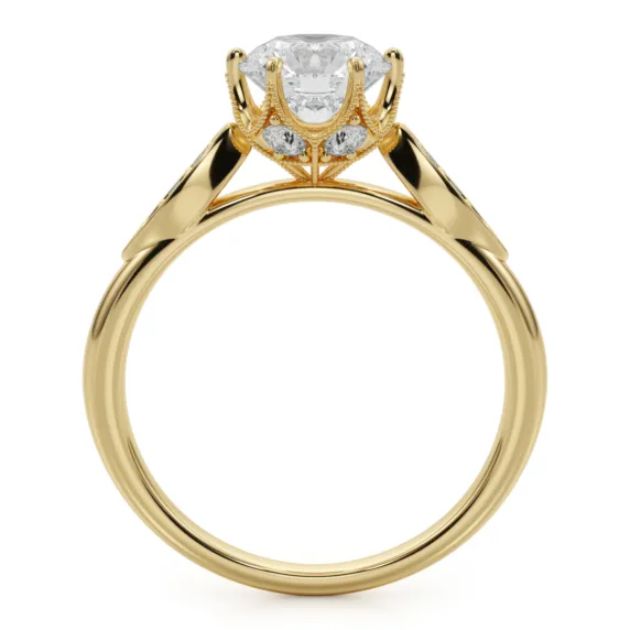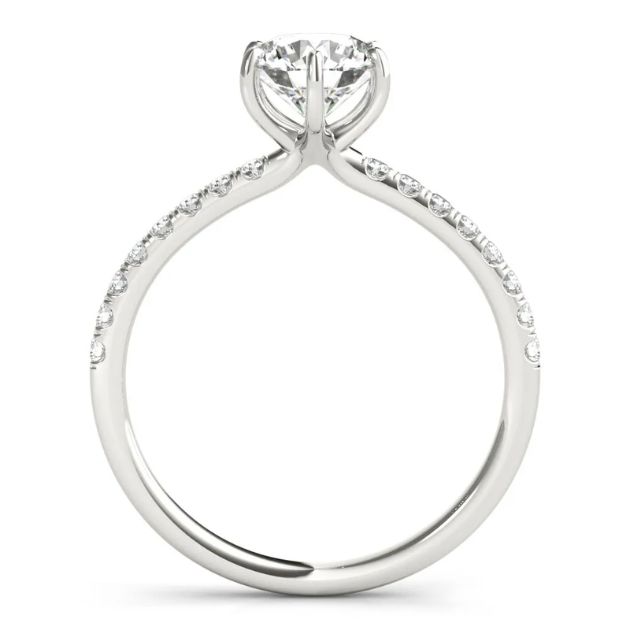With so many options available, it’s essential to understand the intricacies of different settings to ensure your ring will not only look stunning but also stand the test of time. Two popular choices are ring basket setting and prong setting, each offering unique advantages and aesthetics.
Dive into the world of ring settings with us as we unravel the mysteries of ring baskets and prong settings and help you make an informed decision for your precious symbol of love.
Quick Tips
- Basket settings offer an elegant and secure alternative to prong settings, with design options for customization.
- Prongs are renowned for their ability to maximize light entering the stone, but regular maintenance is necessary.
- When selecting a setting, consider personal preferences, the visibility/brilliance of the diamond, and cost considerations such as material & labor costs.
Understanding Ring Basket Settings

The basket-like structure of basket settings securely holds the center stone in place on an engagement ring. They offer a distinct and elegant look, setting them apart from the more commonly found prong settings. With horizontal bands and a fuller encasement of the gemstone, basket settings provide an alternative design that’s both secure and visually appealing.
Moreover, this halo setting style allows more light to permeate the gemstone, thereby enhancing its brilliance and luster.
Components of a Basket Setting
A basket setting comprises horizontal bands and prongs, which together create a secure and stylish setting for your diamond or gemstone. The horizontal bands wrap around the lower part of the diamond’s pavilion, making it a popular choice for a basket engagement ring. This setting style is different from other settings, like halo settings, which typically do not have horizontal bands.
Nevertheless, the complexity of the basket setting makes it relatively more challenging to clean than a prong setting, whose traditional prongs extend from the base. Dirt and debris can accumulate in the small spaces of the basket setting, making it essential to maintain regularly to keep your gemstone sparkling.
Variations in Basket Settings
Basket settings offer a range of design options, allowing for unique and personalized engagement rings. For example, the sides of the basket can be adorned with intricate floral designs, providing a unique perspective when viewed from the side, unlike traditional prong settings that simply hold the diamond in place.
Some popular variations include the cathedral setting with a basket and the option of four or six prongs, catering to individual preferences and design requirements.
Understanding Prong Settings

Prong settings, on the other hand, feature metal prongs that extend upwards from the ring’s base, securely holding the diamond or gemstone in place. This setting style is renowned for maximizing the amount of light that enters and exits the stone, which in turn enhances its brilliance.
Prong settings are popular due to their classic appeal and the emphasis they place on the center stone, making it the star of the show in a prong engagement ring.
Types of Prong Settings
Various types of prongs are used in prong settings, such as:
- Claw prongs are often used to secure round and oval gemstones. They taper inwards to a point, providing a snug fit.
- Flat-tab prongs
- Button prongs
- Round prongs
- V-shaped prongs
Each type of prong has its unique characteristics and advantages.
The prong setting is a widely used jewelry setting. Its variation, the compass point prong setting, adorns the gemstone with four separate prongs located in North, South, East, and West directions. This type of setting creates a striking and modern look while providing a secure hold of your gemstone. Another popular choice is the six-prong setting, which offers enhanced protection for larger stones.
For gemstones with sharp points or corners, such as princess cut, marquise cut, and pear-shaped diamonds, a V prong setting is ideal because it’s specifically designed to secure gemstones with pointed or angular edges.
Maintenance Requirements
While prong settings are undeniably beautiful and enhance the diamond’s brilliance, they do require some maintenance to ensure the gemstone remains secure. Over time, the prongs may become frail, leading to the potential of bending or even breaking.
Regular inspection of your prong setting for weakened prongs and having them repaired or replaced when necessary is vital to avoid losing your precious gemstone.
Comparing Aesthetics: Basket vs. Prong Settings

In comparing the aesthetics of basket and prong settings, factors like diamond visibility, design options, and the impact of the setting on the diamond’s brilliance should be taken into account.
Both settings offer their unique charm, with basket settings providing a more intricate design and prong settings focusing on maximum light performance and diamond sparkle.
Ultimately, the choice between the two settings will depend on personal preferences and the desired overall look of the engagement ring.
Diamond Visibility and Brilliance
A key factor when comparing basket and prong settings is how each setting impacts the diamond’s visibility and brilliance.
A prong setting:
- Displays the most amount of diamond compared to other settings
- Maximizes the amount of light that enters and exits the stone, thereby improving its brilliance
- Ideal for those who prioritize the sparkle of their diamond above all else
In contrast, basket settings encompass more metal than prong settings, which can partially obscure the diamond’s side view. However, basket settings still allow light to enter the gemstone, enhancing its brilliance and luster.
One should consider the importance of light interaction and diamond visibility when choosing between these two settings.
Design Options and Customization
Both basket and prong settings offer a variety of design options and customization possibilities.

Basket settings can be adorned with intricate designs on the sides of the basket, creating a unique and personalized engagement ring.

One popular choice for a stunning engagement ring is the basket and prong setting, which combines the best of both worlds.

Similarly, prong settings can be customized with various prong shapes and arrangements to suit your style and preferences, including traditional prongs extending.
In picking between the two settings, the available design options and their alignment with your personal aesthetic should be assessed.
Assessing Durability and Security
Durability and security are crucial factors to consider when selecting a setting for your engagement ring. Both basket and prong settings offer suitable levels of security for an engagement ring that will be worn for extended periods. However, each setting style has its pros and cons, such as the risk of a high set diamond in a prong setting snagging on clothing or other objects.
In deciding between the two settings, weighing the advantages and disadvantages and considering how they align with your lifestyle and daily wear, is essential.
Active Lifestyles and Wear
For those with more active lifestyles, the choice between basket and prong settings is especially important.
Basket settings are generally more secure and robust than prong settings, making them a preferable option for those who engage in sports or other activities that may put the ring at risk of damage.
Prong settings, while still suitable for active lifestyles, may provide less security than alternative settings such as a bezel setting.
Protection Against Damage
When it comes to protection against damage, a basket setting offers enhanced security as it secures the diamond on all sides and sits lower on the setting. This design provides greater protection against potential damage to the diamond.
Conversely, a prong setting secures the diamond on four or six sides and sits higher on the setting, potentially exposing the diamond to more risks. The decision between these two settings hinges on the level of protection you seek for your precious gemstone.
Choosing the Right Setting for Your Engagement Ring

Selecting the right setting for your engagement ring is a personal decision that should take into account various factors such as personal preference, lifestyle, and budget.
Whether you opt for the elegance of a basket setting or the classic brilliance of a prong setting, your engagement ring will be a beautiful representation of your love story and a cherished heirloom for generations to come.
Browse Clean Origin’s catalog of prong and basket settings with a myriad of center stone and metal options. Remember, there is a conglomerate of details that make up the perfect ring. So, the setting is not the only aspect worth deep consideration.
Factors like 4Cs and metal color have the ability to change the optical appearance of a diamond’s light interaction. Different combinations of diamond shape, ring setting, and metal color can mean you have a ring that appears larger and brilliantly flawless at a budget-friendly price.
Need assistance understanding these tips in practice, never hesitate to contact one of our diamond experts.
Frequently Asked Questions
What is a basket-setting ring?
A basket setting ring is a type of prong setting that has horizontal bands connecting the traditional prongs. It creates a basket-like structure to nestle the gemstone. This provides a secure and elegant way to showcase the stone.
What are the types of ring settings?
Engagement rings come in many varieties, including solitaire, halo, pavé, bezel, channel, and three-stone styles. Each has its own features and characteristics.
Other ideations of settings are much more focused on the intricate details of a ring that are among another category.
For example, prongs are essential to ring anatomy in different popular settings. With that, you can refer to rings with them as prong settings as a way to narrow down your research.
How do bezel settings work?
A bezel setting is a type of engagement ring where the diamond is held in place by a metal rim. It provides extra protection for the center stone. It’s characterized by a ring of metal that overlaps the edges of the stone. Bezel settings offer a secure hold and protection from snagging on clothes, bag handles, or other items.
The bezel setting is a popular choice for engagement rings because it is secure and offers a classic look. It is also a great option for those who are looking for a ring that is low-maintenance.



